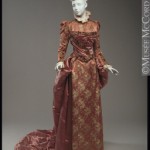Detailing Changes in Victorian Dresses Over the Decades
“Someday,” I keep telling myself, “I’m going to join an SCA group, or go to a Steampunk con, or dance the night away in full costume at Victorian Ball.” It hasn’t happened yet, but I love researching antique fashions in hopes of someday getting my act together and actually creating something. Regardless of my laziness relating to costume construction, you can still benefit from my research: check out this great Victorian fashion resource.

The McCord Museum of Canadian History has a wonderful online exhibit detailing how fashion changed in women’s dress during the reign of Queen Victoria. The zoomable photos of 16 dresses that they feature are accompanied by detailed descriptions as well as summaries of the changes from previous years and short biographical information on the original owners in some cases.
This is one of the best illustrated, concise summaries of the differences in fashion throughout the 1800s that I’ve seen to date. Starting with the empire-waist gowns of the late Regency period, it describes the rise and decline of the gigot (leg-of-mutton) sleeve, the ever-expanding crinoline skirts found mid-century, and the transformation of the bell-shaped crinoline into the infamous bustle of the early 1870s and late 1880s. And while fashion plates are all well and good for looking at the changes in fashion, seeing these museum-quality full-color photographs of extant dresses brings the experience to a new level.
So, without further ado—the link: Form and Fashion Web Tour
In case you’re short on time and want a quick primer, here are some of the major differences between the decades:
- pre-1830s
- Empire waists and loose, straight skirts echoing societal interest in Classical art and form. Skirts slowly get fuller and sleeves start poofing at the shoulder as the 1830s approach.
- 1830s
- Gigot sleeves, also called leg-of-mutton sleeves, are the defining feature of the early part of the decade’s fashion, although they flatten out toward the end. Skirts continue to get fuller, with gores and pleating at the waist aiding the new silhouette.
- 1840s
- Sleeves have deflated and waists have dropped to the natural waistline.
- 1850s
- Waists continue to drop, and skirts become even fuller, with flounces adding additional poof to the skirts.
- 1860s
- Skirts hit their maximum breadth in the early part of the decade, and then begin to transition toward an elliptical shape—the front of the skirt flattens out and the bulk of the skirt moves to the back.
- 1870s
- The bustle has evolved from the elliptical shaping of the late-60s skirts. Bodices and basques have become increasingly short-waisted. Toward the end of the decade, the back of the skirt flattens out a little.
- 1880s
- In the later part of the decade the bustle comes back with a vengeance, requiring a stiff frame to hold the shape. Very late in the decade, sleeves start poofing.
- 1890s
- Skirts become flatter, but the gigot sleeve makes a comeback, jumping off of the poofing sleeves of the late 80s. Moving toward the 20th century, sleeves deflate and bodices begin to change as new styles, such as the bolero, become popular.


Comments are closed.